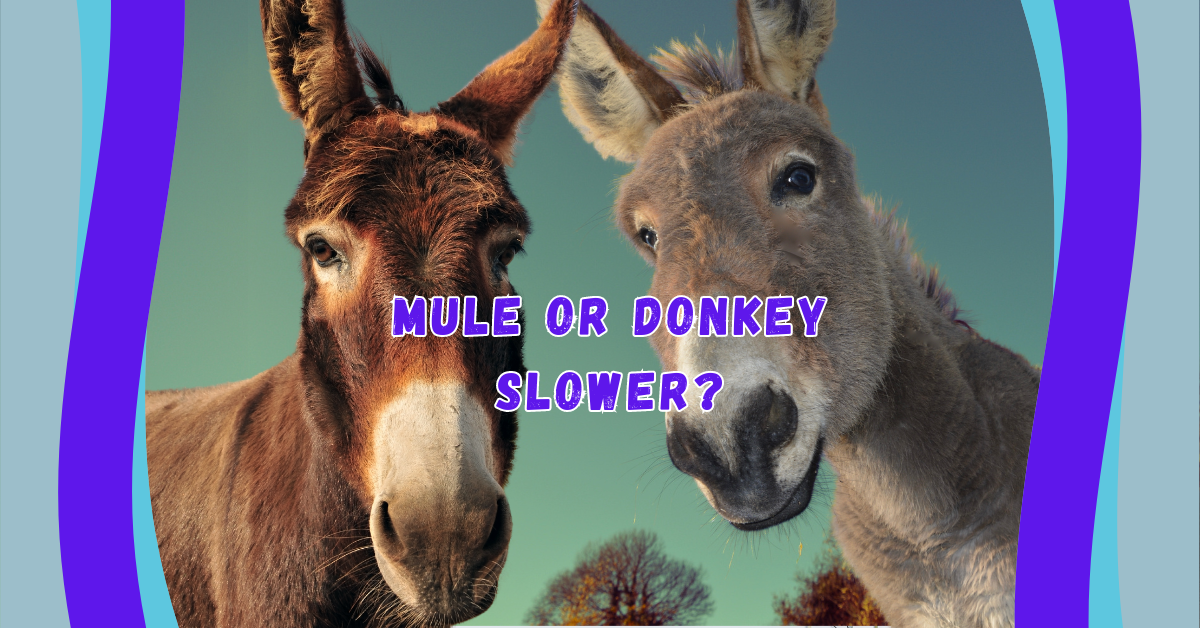When it comes to the world of working animals, mules and donkeys are known for their strength, endurance, and ability to carry heavy loads. However, one question often arises: is a mule or donkey slower? The answer might surprise you, as there are notable differences between these two animals in terms of speed and overall efficiency. While both animals are highly valued for their hardworking nature, understanding their unique characteristics helps explain why mules are often considered faster than donkeys.
In this blog post, we’ll explore the 5 surprising reasons why mules are faster than donkeys, shedding light on their physical traits, behaviors, and environmental adaptations. We’ll also compare the factors that affect their speed and highlight practical uses for both animals in various fields, from agriculture to transportation. Let’s dive into the mule vs donkey speed debate and find out which one is truly slower.
1. Mule vs Donkey: Understanding the Differences
Before diving into the comparison of speed between mules and donkeys, it’s important to understand the fundamental differences between these two animals. Both mules and donkeys belong to the equid family, which also includes horses and zebras, but they are different species with distinct characteristics.
Donkey:
- Species: Donkeys (Equus asinus) are domesticated animals that originated from wild asses found in Africa and Asia.
- Physical Traits: Donkeys have long ears, short stocky bodies, and sturdy legs. They are known for their resilience and ability to thrive in harsh, arid environments.
- Temperament: Donkeys are often viewed as calm, steady, and sometimes stubborn. Their slow pace and deliberate movements are linked to their cautious behavior.
Mule:
- Species: Mules are hybrid animals resulting from the crossbreeding of a male donkey (jack) and a female horse (mare).
- Physical Traits: Mules inherit characteristics from both parents, including the strength and size of horses combined with the endurance and surefootedness of donkeys. They tend to be larger and stronger than donkeys.
- Temperament: Mules are known for their intelligence, hard work, and efficiency. They possess a blend of their parents’ traits, making them faster and more agile than donkeys.
While both animals are prized for their utility, these differences in physical build, temperament, and origin play a significant role in determining their speed and efficiency. In the next section, we’ll take a closer look at the speed comparison between mules and donkeys.
2. Speed Comparison: Are Mules or Donkeys Slower?
When it comes to speed, mules generally outperform donkeys due to their hybrid genetics and physical traits. Let’s break down the speed comparison between the two:
Donkeys’ Speed:
Donkeys are known for their slow and steady pace. On average, donkeys can travel at speeds of 8 to 15 miles per hour (mph) over short distances, but they are typically much slower over longer distances. Donkeys prioritize caution and safety, and they often take their time assessing their surroundings, which is why they are considered slower.
Mules’ Speed:
In contrast, mules can travel faster than donkeys, thanks to their horse-like traits. Mules can reach speeds of up to 20 to 25 miles per hour (mph) at a gallop, but their true strength lies in their ability to maintain a faster pace over longer distances compared to donkeys. Mules inherit the speed and agility of horses while retaining the endurance and toughness of donkeys, making them faster and more versatile animals for work and transport.
Why Mules Are Faster:
- Longer legs: Mules tend to have longer legs and more powerful muscles than donkeys, allowing them to cover more ground with each stride.
- Better stamina: Mules can sustain their speed over longer distances, while donkeys may tire out more quickly due to their smaller size and stocky build.
- Horse genetics: The horse genes inherited by mules contribute significantly to their increased speed and agility, giving them an advantage over donkeys in terms of movement.
The combination of these factors explains why mules are generally faster than donkeys, both over short bursts and long-distance travel.
3. Factors That Affect the Speed of Mules and Donkeys
Several factors influence the speed of both mules and donkeys, from their physical build to environmental conditions. Here are some of the key factors that can affect how fast each animal can travel:
1. Physical Build
Mules tend to have a taller and more muscular build compared to donkeys, which are shorter and stockier. This difference in body structure gives mules a mechanical advantage when it comes to speed, as they can generate more power with each stride. The longer legs and larger muscles of mules allow them to maintain faster speeds over uneven terrain.
2. Endurance
One of the most important factors in determining the speed of any animal is endurance. While both mules and donkeys are known for their ability to carry heavy loads over long distances, mules typically have better stamina. Their horse-like characteristics give them the ability to travel long distances at a steady pace without tiring as quickly as donkeys.
3. Terrain
The type of terrain plays a significant role in determining the speed of mules and donkeys. Donkeys are surefooted and excel in rugged, mountainous areas where agility and balance are more important than speed. Mules, on the other hand, can handle a wider variety of terrains, including flat plains and mountainous regions, but they can move faster on open, smooth terrain.
4. Load and Weight
Both mules and donkeys are often used for carrying heavy loads, which can impact their speed. The heavier the load, the slower the animal will move. Mules, due to their larger size and stronger build, can carry heavier loads more efficiently without sacrificing too much speed, while donkeys might slow down significantly when burdened.
These factors highlight why mules are generally faster than donkeys, especially when considering their build and endurance.
4. Why Donkeys Are Considered Slower Than Mules
Donkeys have earned a reputation for being slower than mules, and there are several reasons behind this perception. While donkeys are known for their strength, endurance, and surefootedness, their slower pace is often attributed to both physical and behavioral traits.
1. Cautious Nature
Donkeys are naturally more cautious than mules or horses. This cautious behavior can cause them to move more slowly, as they take time to assess their surroundings before continuing on their path. Donkeys are known to be stubborn at times, which contributes to their slower pace, as they may refuse to move if they sense danger or are unsure of the terrain.
2. Smaller Size and Shorter Stride
Compared to mules, donkeys have a smaller size and shorter legs, which naturally limits their stride length and speed. Their shorter legs result in a slower, more deliberate pace, especially when carrying heavy loads or traversing difficult terrain. The shorter stride length also means that donkeys are not built for speed but rather for endurance and reliability, particularly in tough environments.
3. Lower Muscle Mass
Mules inherit the muscular strength and power of horses, which allows them to move faster and carry heavier loads with greater ease. In contrast, donkeys have less muscle mass, which impacts their ability to move quickly, especially over long distances. While donkeys are incredibly durable and can carry heavy loads, their muscle composition is not optimized for speed, making them slower than mules.
4. Evolutionary Adaptation
Donkeys have evolved in arid and rugged environments, where slow and steady movement is more advantageous than speed. Their surefootedness and cautious behavior make them well-suited to mountainous or uneven terrain, but their evolution hasn’t prioritized speed as a key trait. In contrast, mules, with their mixed heritage, are built for more versatile tasks, including faster movement on open plains or flat terrain.
These reasons combined explain why donkeys are considered slower than mules, even though both animals excel in different areas of endurance and work efficiency.
5. Mules in Action: Why They’re Faster and More Efficient
Mules are highly valued for their combination of speed, strength, and endurance, which makes them more efficient for certain tasks compared to donkeys. Here’s why mules are faster and often preferred in scenarios where speed is important:
1. Genetic Advantage
As a hybrid between a donkey and a horse, mules inherit the best traits of both species. Their horse-like agility and strength give them the ability to move quickly over varied terrain. This genetic blend makes mules not only faster but also more capable of sustaining their speed over longer distances compared to donkeys.
2. Longer Strides and Larger Build
Mules are generally larger than donkeys, with longer legs and a more powerful build. This allows them to take longer strides, which increases their overall speed. The added size and muscle mass make mules more efficient in carrying heavy loads without sacrificing their pace.
3. Adaptability to Different Terrains
Mules are highly adaptable and can perform well in various environments, including mountainous regions and flatlands. While donkeys excel in rough, rocky terrain, mules can handle more diverse landscapes, and their speed is not as compromised by changes in terrain.
4. Higher Work Efficiency
Because mules are faster and can carry heavier loads for longer periods, they are often seen as more efficient working animals than donkeys. In agriculture, transportation, and military operations, mules have been the preferred choice when speed and endurance are critical factors.
Mules combine the stamina of donkeys with the strength and speed of horses, making them ideal for tasks that require a balance of power and quick movement. Their unique characteristics allow them to outperform donkeys in many scenarios where speed is a priority.
6. Practical Uses of Mules and Donkeys: Where Speed Matters
While mules and donkeys share many similarities in their roles as working animals, there are certain scenarios where speed becomes a deciding factor in choosing one over the other. Here’s a look at the practical uses of each animal and where speed matters most:
1. Mules in Agriculture and Transportation
Mules are widely used in agricultural work, such as plowing fields, carrying goods, and transporting equipment. Their ability to move quickly while carrying heavy loads makes them highly efficient for farming tasks that require both endurance and speed. In addition, mules are often preferred for long-distance transportation of goods or people, as they can maintain a faster pace over extended journeys compared to donkeys.
2. Donkeys in Rugged Terrain
Donkeys, while slower, excel in rugged, uneven terrain where agility and surefootedness are more important than speed. They are commonly used in mountainous regions where maintaining balance and stability is crucial. For example, donkeys are often employed to carry supplies in areas where mechanized vehicles cannot reach, such as remote hiking trails or steep mountain paths.
3. Military and Historical Uses of Mules
Throughout history, mules have been used by militaries around the world due to their speed and reliability. Their faster pace and ability to carry heavy loads made them invaluable during wartime for transporting supplies, equipment, and even injured soldiers. In contrast, donkeys, with their slower pace, were used primarily in environments where endurance over speed was the priority.
Overall, while donkeys are better suited to slow, steady work in rough environments, mules shine in tasks that require a balance of speed and strength, making them the preferred choice in many agricultural and transportation roles.
7. Maintaining the Health and Speed of Mules and Donkeys
To ensure that mules and donkeys perform at their best, it’s essential to maintain their health and well-being. Whether you’re working with a mule that needs to maintain its speed for long-distance tasks or a donkey that excels in endurance, proper care is key to optimizing their performance.
1. Balanced Diet
Providing a nutrient-rich diet is crucial for both mules and donkeys. Their diet should include hay, grains, and fresh water to ensure they have the energy and strength needed for their tasks. Mules, especially, need a higher intake of energy-rich foods if they are expected to perform speed-related tasks, while donkeys require a steady, balanced diet to support their endurance work.
2. Regular Exercise
Both mules and donkeys benefit from regular exercise, which helps them maintain muscle strength, agility, and stamina. For mules, exercise that includes galloping or trotting over various terrains can help keep their speed up. Donkeys, though slower, also benefit from activities that promote endurance and surefootedness, such as climbing and walking in rugged environments.
3. Proper Hoof Care
Hoof health is incredibly important for both animals, especially since they work in tough environments. Regular hoof trimming and care are necessary to prevent injury and ensure that mules and donkeys can move efficiently without discomfort. Mules, with their faster pace, need hooves that are well-maintained to avoid tripping or slowing down.
4. Rest and Recovery
Both mules and donkeys need adequate rest to recover from long workdays. Providing a comfortable and safe resting space helps them recover and maintain their strength for future tasks.
By following these care practices, you can ensure that your mules and donkeys remain healthy and perform their duties with optimal speed and endurance.
For more exciting blogs, visit our homepage Magzineco.
FAQs About Mule vs Donkey Speed
- Which is faster, a mule or a donkey?
Mules are generally faster than donkeys due to their larger size, stronger build, and horse-like genetics. - How fast can a mule run?
Mules can reach speeds of up to 20-25 mph at a gallop, but their strength lies in maintaining faster speeds over longer distances. - Why are donkeys slower than mules?
Donkeys are slower due to their shorter legs, smaller build, and cautious nature, which makes them prioritize safety over speed. - Can donkeys be faster in certain terrains?
Yes, donkeys can excel in rough or mountainous terrains where speed is less important than stability and surefootedness. - Are mules better for long-distance travel?
Yes, mules are better suited for long-distance travel because they can maintain a faster pace over extended periods compared to donkeys. - What factors affect the speed of mules and donkeys?
Factors include physical build, endurance, terrain, and load being carried. - Do mules inherit speed from horses?
Yes, mules inherit horse-like speed and agility, which makes them faster than donkeys while retaining the endurance of their donkey parent. - How can I make sure my mule stays fast and healthy?
Regular exercise, a balanced diet, hoof care, and adequate rest will help maintain a mule’s speed and health. - Is a mule or a donkey better for agricultural work?
It depends on the task—mules are faster and more efficient for larger fields or long-distance work, while donkeys are better for rugged, difficult terrains. - Can a donkey ever outrun a mule?
While unlikely due to their natural differences in speed, donkeys may move more efficiently on extremely steep or rocky terrains where caution is needed.
Conclusion
In the mule vs donkey debate, it’s clear that mules tend to be faster and more efficient when it comes to speed-related tasks, thanks to their horse-like agility and stronger build. However, donkeys hold their own in rugged terrains where stability and caution are required. Both animals have their strengths—while mules are more suited for long-distance travel and faster work, donkeys excel in environments that demand surefootedness and endurance over speed.
Ultimately, the choice between a mule and a donkey depends on the specific needs of the task. Whether you need speed, strength, or steady reliability, understanding the characteristics of both animals will help you make the best choice for the job. By maintaining their health and caring for their physical needs, you can ensure both mules and donkeys perform their roles efficiently and effectively.




